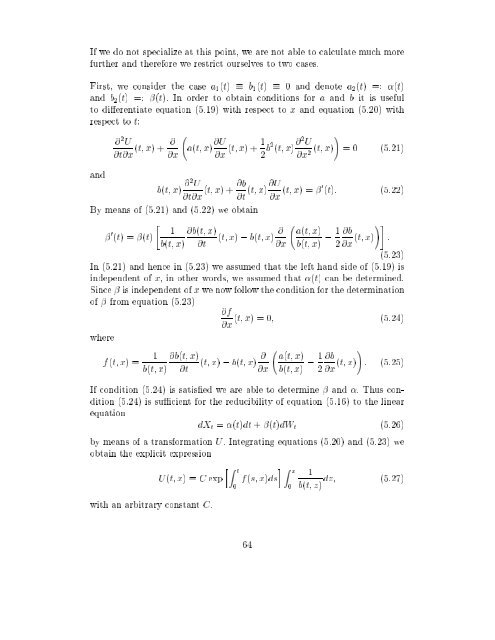Estimation in Financial Models - RiskLab
Estimation in Financial Models - RiskLab
Estimation in Financial Models - RiskLab
You also want an ePaper? Increase the reach of your titles
YUMPU automatically turns print PDFs into web optimized ePapers that Google loves.
If we do not specialize at this po<strong>in</strong>t, we are not able to calculate much more<br />
further and therefore we restrict ourselves to two cases.<br />
First, we consider the case a 1 (t) b 1 (t) 0 and denote a 2 (t) =: (t)<br />
and b 2 (t) =: (t). In order to obta<strong>in</strong> conditions for a and b it is useful<br />
to dierentiate equation (5.19) with respect to x and equation (5.20) with<br />
respect to t:<br />
!<br />
@ 2 U @<br />
(t; x)+ a(t; x)@U<br />
@t@x @x @x (t; x)+1 2 b2 (t; x) @2 U<br />
@x (t; x) =0 (5.21)<br />
2<br />
and<br />
b(t; x) @2 U<br />
(t; x)+@b(t; x)@U<br />
@t@x @t @x (t; x) =0 (t): (5.22)<br />
By means of (5.21) and (5.22) we obta<strong>in</strong><br />
"<br />
0 1 @b(t; x)<br />
(t) =(t)<br />
(t; x) , b(t; x) @ a(t; x)<br />
b(t; x) @t<br />
@x b(t; x) , 1 !#<br />
@b<br />
2 @x (t; x) :<br />
(5.23)<br />
In (5.21) and hence <strong>in</strong> (5.23) we assumed that the left hand side of (5.19) is<br />
<strong>in</strong>dependent of x, <strong>in</strong> other words, we assumed that (t) can be determ<strong>in</strong>ed.<br />
S<strong>in</strong>ce is <strong>in</strong>dependent ofx we now follow the condition for the determ<strong>in</strong>ation<br />
of from equation (5.23)<br />
@f<br />
(t; x) =0; (5.24)<br />
@x<br />
where<br />
f(t; x) = 1<br />
b(t; x)<br />
@b(t; x)<br />
(t; x) , b(t; x) @<br />
@t<br />
@x<br />
a(t; x)<br />
b(t; x) , 1 !<br />
@b<br />
2 @x (t; x) : (5.25)<br />
If condition (5.24) is satised we are able to determ<strong>in</strong>e and . Thus condition<br />
(5.24) is sucient for the reducibility of equation (5.16) to the l<strong>in</strong>ear<br />
equation<br />
dX t = (t)dt + (t)dW t (5.26)<br />
by means of a transformation U. Integrat<strong>in</strong>g equations (5.20) and (5.23) we<br />
obta<strong>in</strong> the explicit expression<br />
U(t; x) =C exp<br />
with an arbitrary constant C.<br />
Z t<br />
0<br />
Z x<br />
f(s; x)ds<br />
0<br />
1<br />
dz; (5.27)<br />
b(t; z)<br />
64
















